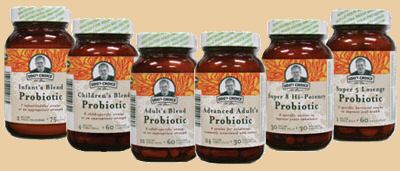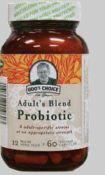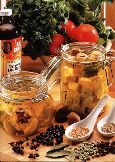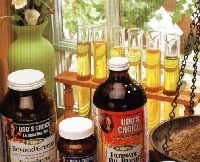|
|


NEW!
PROBIOTICS PDF FILE AVAILABLE to download!
Probiotics
derive from the extensive group of friendly micro-organisms
already present in nature that we commonly obtain
from yogurt and raw foods. Udo's Choice™ Probiotic
Blends consist of SIX distinct varieties, each engineered
for a specific age group or condition: Infant's
Blend, Children's
Blend, Adult's Blend, Advanced
Adult's Blend (for seniors), Hi-Potency Bowel Blend, Super
8 Hi-Potency, and Super
5 Lozenge. Click on any of these links for further information
on Udo's Choice Probiotics Blends!

READ HEALTH.MSN.COM >>
"THE BACTERIA YOU WANT IN FOOD"

Why do we need them? How can they benefit us?
What are probiotics? The human gastrointestinal tract is
home to more than 400 types of probiotics (ie, "friendly" bowel
bacteria, gut microorganisms, or intestinal flora). In fact, more
probiotics live in a person's mouth than there have ever been human
beings on this Earth.
These "friendly" microorganisms protect the GI tract (from mouth to anus)
and keep us healthy by protecting us from "unfriendly" microorganisms such
as bacteria, yeasts, and fungi that cause disease. They also improve immune system
function, and have other health benefits (see lists below).
 Where
do probiotics come from? Where
do probiotics come from?
Scientists have identified
about 4,000 species of bacteria, and estimate from 400,000 to 4
million actually exist. Good (and bad) bacteria live virtually
everywhere! No matter where we go or what we do, we come into contact
with them, but certain sources act as "primary sources" of probiotics
for us.
During birth, probiotics from the mother's birth canal colonize the infant's
gut, and thereafter are provided by mother's milk. After infancy, probiotics
are supplied to us by raw foods (grown on uncontaminated soil); lactic acid bacteria-fermented
foods such as yogurt and cheese; and probiotic supplements.
Unfortunately, we also come into
contact with disease-causing bacteria which are responsible for
about half of all human disease. These include some yeasts (Candida and others), Salmonella, Listeria,
Montezuma's Revenge, Amoeba, certain E-coli strains, Botulinum
and, in places without sanitation, the deadly Typhus and Cholera.
- Out-populating and inhibiting the growth of "unfriendly" microorganisms;
- Replacing "good" bacteria killed by taking antibiotics (antibiotics
kill "bad" bacteria as well as the "good" ones) or cooking foods;
and
- Manufacturing chemicals absorbed into the body that the immune
system uses to control the "bad" microorganisms.
Any action taken to kill "bad" bacteria essentially kills "good" bacteria
as well. For example, cooking foods, taking antibiotics, or using
mouthwash will also destroy the organisms meant to protect us.
Replacing them is accomplished easily with quality probiotic supplements.
- Enhance the immune system's
ability to fight infections throughout our tissues;
- Provide a main source
of Vitamin K;
- Lower cholesterol by
metabolizing it;
- Control bowel toxicity
and decrease the risk of bowel cancer; and
- Reduce gas production
by non-disease-producing microorganisms.
About 20 different probiotics
are grown commercially in dairy or non-dairy cultures. A combination
of one or more of these probiotics can be added to cold or warm
(up to 120°F or 50°C) foods to replace the ones killed
by cooking.
All probiotic supplements work most effectively if taken after meals, when stomach
acid is lowest. Stomach acid destroys up to 99.9% of probiotics if taken before a
meal but only about 90% if taken after the meal.
Thus, after-meal intake ensures maximum delivery to the small
intestine where they reproduce rapidly, populating the colon. They
do most of their good work in the small and large intestines, but
they also help the mouth and esophagus to remain uninfected. In
order to stay alive, probiotics should be kept refrigerated.
 Flora's
dating process is based on the "time of manufacture",
which means that the bacterial count on the bottle reflects the
number of bacteria in each capsule at the time it was made. The
bacterial count found on Udo's Choice Probiotic labels reflects
only the number of viable or active bacteria in the product. Any
damaged or ineffective bacteria were not included in the count. Flora's
dating process is based on the "time of manufacture",
which means that the bacterial count on the bottle reflects the
number of bacteria in each capsule at the time it was made. The
bacterial count found on Udo's Choice Probiotic labels reflects
only the number of viable or active bacteria in the product. Any
damaged or ineffective bacteria were not included in the count.
We can assume a 2%–4% decrease per month if the product
has been kept refrigerated, for example 30 billion viable cells
at a 2% decrease will contain 23.5 billion viable cells after 12
months. If left at room temperature, for 30 days an encapsulated
product will experience a 20%–40% decrease in bacterial count.
A 25% decrease can be expected for an unrefrigerated lozenge product.
Udo's Choice Probiotics boast some of
the largest bacterial counts available at time of manufacture so that even by the expiry date you will still be getting
all the probiotics you need for proper digestion, strong immune function & overall
health.
Refrigeration ensures maximum potency and
stability, however Udo's Choice Probiotics can be left unrefrigerated
for short periods of time, making them convenient for travel. All
Udo's Choice Probiotics may be frozen to further extend shelf life.
This process, which is both simple
and complex, is one where state-of-the-art
equipment and the knowledge of expert technicians play a key role
in order to produce probiotics at the highest possible standardized
concentration. 
- Mother-culture & Fermentation
The bacteria proliferate in culture media of increasing volume, until they
are placed in the fermentor. The resulting probiotic culture goes from clear
to cloudy as the bacteria reproduce
- Filtration
Once fermentation is complete, the culture is then concentrated to reduce its
volume and protected to survive the next phase.
- Lyophilization (freeze-drying)
The concentrated bacterial culture is frozen at – 40°C. Then, through
a process called sublimation, the ice is converted into steam, yielding a solid
crust ready for grinding.
- Grinding
The crust is then gently ground into a fine powder with a high bacterial concentration.
This is called the pure culture.
-
Mixing
The pure culture is mixed with excipients to make the subsequent encapsulation
or compression phase possible.
- Packaging
Specific Udo's Choice Probiotics are available in powder, capsule or lozenge
formats. Flora uses vegetarian capsules because of their low moisture content
which prolongs the shelf life of moisture sensitive products such as probiotics.
Flora uses only light-resistant, recyclable, non-reactive, nitrogen flushed,
dark brown glass bottles which prolong stability and product integrity.
Bacteria
were the first living creatures on Earth, more than 3.5 billion
years ago. They are an evolutionary success story that has been
around for 2 billion years longer than have humans and all other
animals!
Contrary to what most people understand, only a fraction of existing bacteria
actually cause disease in humans or other living creatures. In fact, the majority
of bacteria are absolutely essential to life on planet Earth.
- Decompose dead matter into inorganic chemicals and return them
to the environment where they sustain plant life, which animals
consume to live;
- Form symbiotic relationships with other living creatures and
are believed to be the ancestors of all other life forms; and
- Act as defense against foreign invaders and maintain gut integrity
in living creatures
- Decompose sewage (methanogens);
- Decompose synthetic chemicals such as pesticides (soil bacteria
called proteobacteria);
- Make vitamins and antibiotics. Over 50% of antibiotics are
produced by soil bacteria (Streptomyces);
- Convert milk into yogurt and different types of cheese, and
make other fermented
foods such as miso and tempeh, all of which are valuable food sources for
us.
Udo has formulated SIX INDIVIDUAL PROBIOTICS FORMULAS specially
made for certain age groups and conditions! Follow these links
to find out more! Infant's
Blend, Children's Blend, Adult's
Blend, Advanced Adult's
Blend (for seniors), Super
8 Hi-Potency, and Super
5 Lozenge.
References:
- Murray, Michael T.,
ND,Encyclopedia of Nutritional Supplements. Prima Publishing,
1996.
- Shahani, Khem. Personal
communication, 1998.
- Chaitow, Leon N.D.,
D.O., and Natasha Trenev, Probiotics: How Live Yogurt and
Other 'Friendly Bacteria' Can Restore Health and Vitality.
Hohm Press, 1995.
- Hentges, DJ (ed.), Human
Intestinal Microflora In: Health and Disease. Academic
Press, New York, NY, 1983.
- Campbell, Neil A., Biology,
Fourth Edition. The Benjamin/Cummings Publishing Company, Inc.,
1996.von Wright A., Salminen S., Probiotics: established effects
and open questions. Eur J Gastroenterol Hepatol 1999
Nov;11(11):1195-8. University of Kuopio, Institute of Applied
Biotechnology, Finland.
- Saavedra J., Probiotics
and infectious diarrhea. Am J Gastroenterol 2000 Jan;95(1
Suppl):S16-8. Johns Hopkins Medical Center, Baltimore, Maryland
21287, USA.
- Evans J.S., Huffman
S., Update on medications used to treat gastrointestinal disease
in children. Curr Opin Pediatr 1999 Oct;11(5):396-401.
Division of Pediatric Gastroenterology and Nutrition, Nemours
Children's Clinic, Jacksonville, Florida 32207, USA.
- Anderson J.W., Gilliland
S.E., Effect of fermented milk (yogurt) containing Lactobacillus
acidophilus L1 on serum cholesterol in hypercholesterolemic
humans. J Am Coll Nutr 1999 Feb;18(1):43-50. Metabolic
Research Group, VA Medical Center, University of Kentucky,
Lexington 40511, USA.
- Elmer G.W., Surawicz
C.M., McFarland L.V., Biotherapeutic agents. A neglected modality
for the treatment and prevention of selected intestinal and
vaginal infections. JAMA 1996 Mar 20;275(11):870-6.
Department of Medicinal Chemistry, School of Pharmacy, University
of Washington, Seattle 98195, USA.
- Simenhoff M.L., et al.,
Biomodulation of the toxic and nutritional effects of small
bowel bacterial overgrowth in end-stage kidney disease using
freeze-dried Lactobacillus acidophilus. Miner Electrolyte
Metab 1996;22(1-3):92-6. Department of Medicine and Nephrology,
Jefferson Medical College, Philadelphia, PA 19107-6799, USA.
- Hilton E., et al., Ingestion
of yogurt containing Lactobacillus acidophilus as prophylaxis
for candidal vaginitis. Ann Intern Med 1992 Mar 1;116(5):353-7.
Division of Infectious Diseases, Long Island Jewish Medical
Center, New Hyde Park, NY 11042.
- Reid G., et al., Is
there a role for lactobacilli in prevention of urogenital and
intestinal infections? Clin Microbiol Rev 1990 Oct;3(4):335-44.
Department of Surgery, University of Toronto, Toronto General
Hospital, Ontario, Canada.
- Saavedra J.M., et al.,
Feeding of Bifidobacterium bifidum and Streptococcus thermophilus
to infants in hospital for prevention of diarrhoea and shedding
of rotavirus. Lancet 1994 Oct 15;344(8929):1046-9. Department
of Pediatrics, Johns Hopkins University School of Medicine,
Baltimore, Maryland.
- Shahani K.M., Chandan
R.C., Nutritional and healthful aspects of cultured and culture-containing
dairy foods. J Dairy Sci 1979 Oct;62(10):1685-94.
- Saavedra J., Probiotics
and infectious diarrhea. Am J Gastroenterol 2000 Jan;95(1
Suppl):S16-8. Johns Hopkins Medical Center, Baltimore, Maryland
21287, USA.
- Gorbach S.L., Lactic
acid bacteria and human health. Ann Med 1990 Feb;22(1):37-41.
Department of Community Health, Tufts University School of
Medicine, Boston, MA 02111.
- de Roos N.M., Katan
M.B., Effects of probiotic bacteria on diarrhea, lipid metabolism,
and carcinogenesis: a review of papers published between 1988
and 1998. Am J Clin Nutr 2000 Feb;71(2):405-11. Division
of Human Nutrition and Epidemiology, Wageningen University,
Netherlands.
- von Wright A., Salminen
S., Probiotics: established effects and open questions. Eur
J Gastroenterol Hepatol 1999 Nov;11(11):1195-8. University
of Kuopio, Institute of Applied Biotechnology, Finland.
- Schultz M., Sartor R.B.,
Probiotics and inflammatory bowel diseases. Am J Gastroenterol 2000
Jan;95(1 Suppl):S19-21. University of Regensburg, Department
of Internal Medicine, Germany
|
"Read
Nature, Nature is a Friend to Truth."
-
Edward Young
|
©Udo Erasmus. Use of educational material
without permission is strictly prohibited.
|

